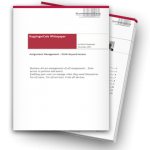As organizations go digital, security standards and requirements are evolving to address risk to enterprise systems and the vital data contained within them. The complexity of the compliance management climate has increased across the board, and organizations are struggling to keep up with the intensified requirements.
Because the process of compliance management has become so taxing on organizations generally, compliance efforts have become exercises in exhaustive reporting at the expense of other security programs that address equally critical and perpetually evolving threats. If you operate in a highly regulated vertical, how do you avoid getting bogged down in the constancy of all-consuming compliance reporting? You fully automate the process.
SANS recently published a study around listing critical security protocols that govern effective compliance management. These controls include account monitoring and control, provisioned access on a need-to-know basis and safeguards around administrative privileges.
Automated access management sits at the helm of an efficient, painless compliance management process. When you automate account monitoring and control, it’s a simple, speedy exercise to run analyses and reports that satisfy compliance requirements. Ideally critical risk controls should be baked into security architectures, policies and roadmaps.
Similarly, it’s vitally important to provision access on a need-to-know basis and establish role-based, automated protocols. When access is tied to the role and not to the individual, the automated system is empowered to ensure that when organizational roles shift access permissions change accordingly. This protects the organization from a legacy user possessing unnecessary, excessive access and ensures compliance.
It’s equally important to establish, implement and automate administrative controls that outline and limit who can access and alter protocols and provisioning guidelines. Super User privileges should be limited to a carefully selected and monitored small group of staff members that need this capability to execute their job functions. Their activities require controls and visibility too.
If the concepts around successful compliance management software seem intuitive, that’s because they are. However, the key to simplifying the process within your organization lies in automation. The idea is to establish and bake-in requirements into the software and let workflow automation perform its magic. That’s how compliance management transforms into process improvement.
The more demanding your regulatory compliance requirements and IT audit schedule, the more your organization will benefit from automating the entire process. Banks, health care organizations and government agencies are subject to such arduous regulatory compliance measures that the audit process is perpetual and requires continuous accountability. As soon as you’re finished with one cycle you’re knee deep in the next.
The good news, according to the SANS study, is that the high level of awareness around enterprise risk management and compliance among top-level executives means that decisions around investing in automation are no-brainers. And, as a result of the publicity around advanced attacks, the impetus to act proactively among organizational leadership collectively is forcefully strong.
What’s important to accept is the fact that the regulatory compliance will continue to evolve and become more stringent and complex. If you can accept this reality and automate compliance management, you will unburden your organization and improve security at a lower cost.
Watch Gwinnett Medical Center talk about automating HIPAA HITECH compliance management for the user account provisioning of systems, equipment and healthcare facilities using and identity managerwith IT automation and self-service administration.
 Get the Free KuppingerCole Identity Management Analyst White Paper
Get the Free KuppingerCole Identity Management Analyst White Paper
Learn the role IT automation and business driven self-service administration play in creating lean operations. KuppingerCole’s Assignment Management — Think Beyond Access describes the shift in IT operations from tightly controlled identity management processes to workflow enabled administration.




